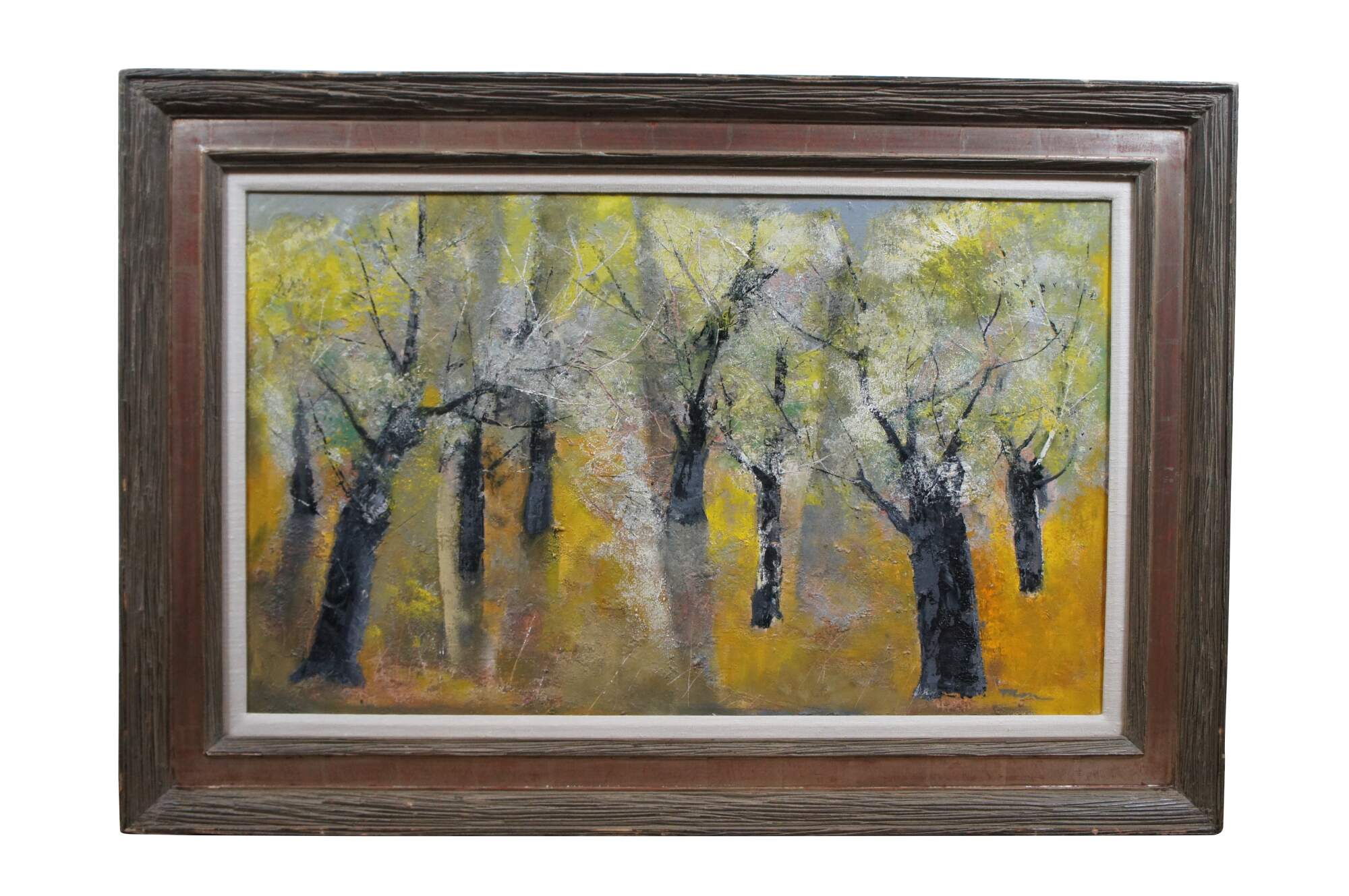
Shipping:
Free Shipping Included
Delivery:
Estimated 2-15 Business Days
Payments:
Credit Card, Check, Cash, PayPal, Apple Pay, Venmo
Returns:
30 Days 100% Money Back Guarantee, Buyer Pays Return Shipping
Description
Mid 20th century oil on board landscape painting by William Thon, titled "Olive Trees," No. 850. Shows an abstract expressionist forestscape with black trunked trees whith green and white leaves over a golden forest floor. Signed lower right corner. Rustic wood frame with red stained recessed bevel and white linen mat. Labels on reverse from Midtown Galleries (New York, New York), Frost Gully Gallery (Portland, Maine). Exhibited at The Ogunquit Museum of American Art (Ogunquit, Maine) - "Creative Lives" July 1 - September 30, 1996.
"William Thon (1906-2000) was an American artist noted for highly abstracted landscape paintings. He debuted as a professional artist in 1939 at the Corcoran Gallery Biennial* exhibition. He was born in New York City in 1906, and spent his childhood summers camping on Staten Island. He also developed a great love of travel, and in 1933 made an eight-month voyage to the Cocos Islands in the Pacific.
He joined the Navy during World War II, and shortly after the war won the Prix de Rome*, a fellowship in Rome to the American Academy,* which he later served as trustee. Recognition for him continued with his participation in the 1942 "Artists for Victory" exhibit at the Metropolitan Museum of Art*, and in 1944, Midtown Galleries in New York held his first one-person show. This gallery then continued to be his representative throughout his career. He had subsequent solo exhibitions at Smith College Art Museum, Fort Wayne Museum and Farnsworth Museum in Rockland, Maine. He earned an honorary Doctor of Arts from Bates College in Lewiston, Maine in 1957, and was a member of The American Academy* and Institute of Arts and Letters, as well as the National Academy of Design*.
In 1947, the year-long study at the American Academy proved highly influential on his career, especially with him beginning to paint as much with watercolor as oil. Returning to America, he submitted a watercolor into the 1949 exhibition of the National Academy of Design, and that year was voted into Academy membership. From thereon, he exhibited frequently at the Academy and won prizes including the Benjamin Altman Prize* in 1951, 1954, 1961, 1967 and 1969.
In 1951, Thon received a grant from the American Academy of Arts and Letters. He also taught painting at Ohio University, and painted aspects of the Apollo Space Program for the NASA Fine Arts Program. He returned often to Italy, and in 1955 served in Rome as Artist-in-Residence at the American Academy. His other travels were extensive and reflected in his paintings, which included scenes from Greece, Ireland, Portugal, Spain and Italy. However, especially influential was his beloved home countryside at Port Clyde, Maine, where he had made his home just after World War II.
This area is credited as providing a major breakthrough stylistically because of his discovery of an abandoned quarry near his property. Here he did numerous and increasingly abstract paintings of spidery trees with rectilinear slabs of interspersed granite. While still based in nature, these were by far the most abstract of any of his paintings. An example being Midnight Quarry.
Thon died in 2000 died at his home in Port Clyde on December 6 at age 94. He had continued to work after macular degeneration had left him legally blind.
From his estate gift of four million dollars, the Portland Museum of Art, Maine, received the biggest cash gift to that time. About $3.8 million was already liquid with the remaining sum to come from sales of Thon's works. The artist's will directed the museum to use the funds to support its juried biennial exhibit of Maine art. He also left $100,000 for the Farnsworth Art Museum in Rockland.
William Thon was awarded innumerable prizes and is represented in over 60 museum collections including The Metropolitan Museum of Art, The Brooklyn Museum, The Hirshhorn Museum, The Butler Institute of American Art, The Columbus Museum of Art, and in Maine, The Farnsworth Art Museum, The Portland Museum of Art, and The Ogunquit Museum of Art." (Source: askART)
Condition
Good Overall - Gentle wear to frame
Dimensions
44" x 1.75" x 30" / Sans Frame - 35.25" x 21.25" (Width x Depth x Height)